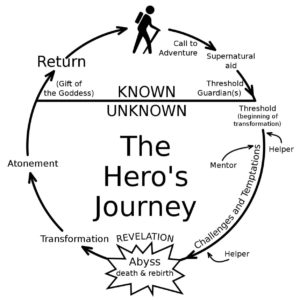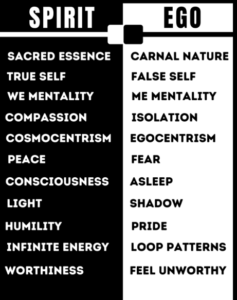Ego-death, also known as ego dissolution or ego loss, is a phenomenon that has intrigued and challenged humanity for centuries. It’s a concept often associated with psychedelic experiences, wherein individuals undergo a profound and sometimes unsettling transformation of consciousness. During ego-death, the boundaries that define our sense of self blur, leading to a deep sense of unity with the cosmos. In this blog post, we’ll explore the meaning of ego-death, its various facets, and its historical significance, highlighting notable figures who have been profoundly impacted by this transformative experience.
Ego-Death Defined
At its core, ego-death represents the dissolution of one’s ego, the familiar sense of “I” or “me” that forms the core of our identity. This experience can range from a mild detachment from the ego to a complete loss of one’s sense of self. Ego-death is often associated with psychedelic substances like magic mushrooms (psilocybin), LSD, or DMT, but it can also occur spontaneously during intense meditation, near-death experiences, or other profound spiritual or psychological events.
The Profound Characteristics of Ego-Death
Ego-death experiences share several common characteristics:
- Loss of Ego-Driven Thoughts and Desires: During ego-death, individuals may find themselves free from the incessant chatter of ego-driven thoughts and desires. The usual worries, ambitions, and preoccupations of daily life fade away.
- A Sense of Unity: Many who experience ego-death describe a profound sense of unity with the universe or all of existence. They feel interconnected with everything around them, experiencing a oneness that transcends their individual identity.
- Timelessness: Time seems to lose its relevance during ego-death. Past, present, and future merge into an eternal now, and individuals may report feeling as though they exist outside the constraints of time.
- Emotional Responses Vary: Ego-death experiences can evoke a range of emotions. Some find it deeply liberating, transformative, and enlightening, leading to feelings of peace and interconnectedness. Others, however, may find it frightening, disorienting, or distressing, particularly if they resist the dissolution of their ego.
Historical Figures and Ego-Death
Throughout history, certain influential figures have encountered ego-death experiences and found them to be instrumental in their personal and creative development:
Aldous Huxley: Aldous Huxley, the celebrated author of the dystopian novel “Brave New World,” embarked on a fascinating journey into the realm of psychedelics and ego-dissolution. In his groundbreaking work, “The Doors of Perception,” Huxley eloquently chronicled his personal encounters with substances like mescaline, offering readers a vivid glimpse into the profound alterations in perception and consciousness induced by these compounds. Huxley’s writing was more than a mere recollection of his experiences; it was a philosophical exploration of the boundaries of human cognition and the potential for expanding one’s consciousness. His articulate and insightful descriptions of ego-dissolution experiences resonated deeply with a generation seeking new avenues of understanding and self-discovery. Huxley’s contributions played a pivotal role in popularizing psychedelics and sparking a cultural fascination with their capacity to unlock hidden realms of human consciousness.
Timothy Leary: Timothy Leary, a psychologist and trailblazing advocate for the responsible use of psychedelics, stands as a towering figure in the history of ego-dissolution exploration. Leary was not content with merely experiencing ego-death himself; he devoted his life to researching and promoting the therapeutic potential of substances like LSD. His belief was that by facilitating ego transcendence through psychedelics, individuals could undergo profound personal growth and transformation. Moreover, Leary held a grand vision that these personal transformations could ripple outwards, ultimately leading to societal change and a more enlightened world. His famous phrase, “Turn on, tune in, drop out,” became emblematic of his advocacy for expanding one’s consciousness and reevaluating conventional norms and values.
Steve Jobs: Steve Jobs, the co-founder of Apple Inc. and an icon of innovation, attributed a significant portion of his creative thinking and visionary outlook to his experiences with LSD. He viewed these experiences as instrumental in expanding his mind and reshaping his worldview. Although Jobs didn’t delve into detailed writings about ego-dissolution, his profound appreciation for the potential of altered states of consciousness was evident in his approach to design and technology. He embraced the idea that thinking beyond the conventional boundaries of thought could lead to groundbreaking innovations, a perspective that undoubtedly left an indelible mark on the tech industry and the world.
Ram Dass (Dr. Richard Alpert): Dr. Richard Alpert, a Harvard psychologist turned spiritual teacher known as Ram Dass, underwent a remarkable transformation after his encounters with psychedelics. His experiences led him on a path of self-realization and spiritual exploration. Ram Dass chronicled his journey in the influential book “Be Here Now,” which became a cornerstone of the spiritual and self-help movements of the 1960s and 1970s. He dedicated his life to promoting self-awareness, personal growth, and the importance of being present in the moment. Ram Dass’s work continues to inspire countless individuals on their own quests for self-discovery and spiritual awakening.
Conclusion
These historical figures, among others, found immense value in their encounters with ego-death. They regarded these experiences as catalysts for personal growth, creativity, and expanded consciousness. The profound insights gained during ego-death experiences led to a deeper connection with the world and a reevaluation of their place in it.
However, it’s important to emphasize that while some individuals have thrived on ego-death experiences, they are not without risks. These experiences can also be disorienting, distressing, or challenging, especially when approached without the right mindset or in an unsupportive environment. Whether ego-death is “bad” or “good” ultimately depends on the individual, their context, and their ability to navigate and integrate the experience effectively.
Commonly Asked Questions
Q: Is ego death permanent?
A: Ego death is usually temporary and reversible, lasting for the duration of the experience.
Q: Can ego death be beneficial?
A: Some people find ego death experiences to be transformative and therapeutic, leading to personal growth and insight.
Q: Are there risks associated with ego death?
A: Ego death experiences can be disorienting and challenging, potentially causing anxiety or existential crisis.
Q: Can ego death be induced intentionally?
A: Yes, through practices like meditation or the use of certain psychedelics, ego death can be intentionally induced.
Q: Where can I buy psychedelic’s in Canada?
A: You can check out our store for a variety of options to choose from!













